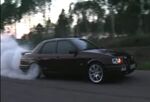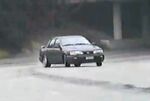Cosworth
Background[edit]
The Ford RS Cosworth marque is the result of a Ford-project with the purpose of "Producing a downright winner for Group A racing events in Europe." At least that's what they told the press. What really happened was a bunch of power crazed petrolheads got together and managed to obtain pictures of the whole of the Ford Motor Company's executive board at a transvestite orgy. After that it was a case of barging into the next board meeting which took place, throwing pictures on the table and demanding carte blanche to build whatever they damn well pleased. Ford's SVO department was born and shortly after, the global rubber shortage. First up was the Sierra Cosworth.
Sierra RS Cosworth[edit]
The project was defined by Stuart Turner in the spring of 1983. He had then recently been appointed head of Ford Motorsport in Europe, and he realized right away that Ford was about as competitive in this area as a Paula Radcliffe is when she needs a dump. In addition to this, Turner was receiving death threats on a daily basis from petrolheads up and down the land, all of them pissed off the Mk II Escort RS2000 had stopped production. Clearly something had to be done.
Therefore, an official request for a turbocharged 4 pot monster (designated Cosworth YBB) was placed with Ford’s long time partner and co-conspiritor in producing mentalist cars, the automotive company Cosworth. Cosworth's response was not officially recorded, but can be considered to run something along the lines of "yeah mate, no bother, Saafend seafront wont know what's hit it". However, they put up two conditions: the engine would produce not less than 204 HP in the street version, had to be tuneable to over 500bhp after Mark Shead got his hands on it and Ford had to accept no less than 15,000 engines. This left an extra 10,000 engines spare after the initial run of 3-door Cossie's, but Turner still had the negatives of the Executive board so he weren't worried. Besides, worst came to worst, he'd flog em' down Billericay market.
In April 1983, Turner’s team decided on the Sierra as a basis for their project. The Sierra filled the requirements for rear wheel drive and decent aerodynamic drag. A racing version could also help to improve the pisspoor reputation that Sierra had earned since the introduction in 1982.
Lothar Pinske, responsible for the car’s bodywork. When it came to appearance Pinske had three criteria to fulfil. Most important was to make every Capri driving street racer east of Stanford-Le-Hope want to up their insurance cover and drive their car into Hanningfield reservoir in order to to afford to buy one. Next up was to make the car's looks good enough to open every pair of legs it passed as it drove past TOTS Nightclub, and also something about making the car stable at high speed too. Experience had shown that in standard trim, the aerodynamic lift the Sierra hatchback body generated was inversely proportional to the skirt it attracted into it's passenger seat.
After extensive wind tunnel testing and test runs round Essex's premier motor racing circuit (Canvey Island), prototypes started to emerge and dealers were invited to test drive sessions. After Ford's target market had tested the cars, car dealers were invited to test drive sessions. After a few laps of North Weld roundabout, they were convinced. In addition, Ford took some radical measures to reduce the price on the car. As an example, the car was only offered in three exterior colours (black, white and moonstone blue) and one interior colour (grey). There were also just two equipment options: with or without central locking and electric window lifts. However, Ford knew their target market wouldn't give a shit about these limitations, mostly cos you don't care what colour your car is when you're poking some Doris in the back seat.
2wd Sierra Sapphire RS Cosworth[edit]
With Porsches across Essex being put in their place by "Some Ford with a towel rail on the back", Turner could have easily called it a day a pissed off down the pub. However, he still had a warehouse full of Cossie engines to use and an army of baseball cap wearing speedfreaks dreaming "Someday..." as a 3-door drove past. The second generation 4 door Sierra Sapphire Cosworth was born and assembled in Genk, Belgium, with the UK-built Ford-Cosworth YBB engine. Suspension was essentially the same with some minor changes in geometry to suit a less aggressive driving style (dropping the ball there Ford! Aint you never been up Basildon on a Saturday night?) and favour ride over handling (again! WTF?!) . Approximately 13,140 examples were produced during 1988-1989 with the total number falling into the following catagories:
3,448 (crashed)
1,143 (stolen)
1,180 (burnt out)
1,306 (ringed)
68 (MINT MATE!)
In the UK, the RHD 1988-1989 Sierra Sapphire RS Cosworth is badged as such with a small "Sapphire" badge on the rear door window trims. All 1988-1989 LHD models are badged and registered as a Sierra RS Cosworth with no Sapphire nomenclature at all. Enthusiasts of the marque are mindful of this, but describe your motor to anyone as a "Saff Cossie" and they'll know not to mess. The net result was an explosion in UK performance car culture which can be best observed by viewing the Cosworth in it's natural habitat, Southend Seafront.
File:Amazing cossie burnouts at passion ford southend
The next question will be guaranteed to be "2WD or 4'Bi'4 mate?" Which leads us onto....
Sierra RS Cosworth 4x4[edit]
With upside down Saffs littering the country's ditches, the enthusiasm for which the car was being driven was often outweighed by the talent of the driver. So in January 1990 the third generation Sierra RS Cosworth was launched, this time with four wheel drive, meaning the accidents that happened before could happen again, but at much higher approach speeds!
The more discreet 4-door Cosworth was considered to have a better market potential. Bank Job getaway drivers and ram raiders were certainly not complaining and the boy racers who were still dreaming of the 3 door, also lusted after the saff 4x4 bonnet due to its new bonnet louvers. Four wheel drive and an increasing amount of equipment had raised the weight by 100kg, and that was all the excuse needed to increase the power to compensate for this.
Cosworth power, coupled with the 4x4 drivetrain was warmly received, with Porsche drivers getting their arses handed to them on a plate continuing until the end of 1992, when the Sierra was replaced by the Mondeo. The replacement for the Sierra RS Cosworth was not a Mondeo however, but the Escort RS Cosworth. Speaking of which....
Escort RS Cosworth[edit]
The Ford Escort RS Cosworth was a "sports" derivative of the Ford Escort. It was available from 1992-96 in very limited numbers. Even more limited these days. The main selling point was the Cosworth YBT engine, a highly tunable turbocharged 2-litre engine which had an output of 227BHP in standard trim. Oh was it bollocks, it was that wing! Look at it! EXACTLY like the one on the 3-door, but higher, HIGHER!!!! The first was was precisely placed to provide enough downforce, but not to produce too much drag. This one? Whacked on and whacked up high so everyone on Southend seafront knew exactly what was coming down the road.
By this point, Turner was nowhere to be found. he was too busy racing anyone stupid enough to take him on after the pulled up to them at the lights, smiled and started revving the bollocks off his 3-door. So Ford developed the car around the chassis and mechanicals of its predecessor, the Sierra Cosworth to accommodate the larger Cosworth engine and transmission, whilst clothing it in Escort body panels to make it resemble the standard Mk V. When using the word "resemble" please bear in mind that "resemble" should be suffixed with the phrase "a MkV after it had spent the previous 6 months ripped to its tits on "test", drinking protein shakes and using the missus as a punchbag"
Changes were made to the engine management system and a new turbocharger was fitted. Permanent four wheel drive with a 34/66% front/rear split came courtesy of an uprated five speed gearbox as used in the Sierra Cosworth. Recaro sports seats came as a standard fitment. Later production models were available without the oversize tail spoiler although by far the majority of owners, when asked if they'd like to tick the delete option for the spoiler by the nice man at Ford, responded by planting them and setting their dogs onto him. Like its Sierra predecessor, they are commonly nicknamed "Cossie" by enthusiasts. Other nicknames include "The Beast", "The Scud Missile", "MADman" and "Bleach".
The Escort Cosworth was a rare car, with 7,145 vehicles produced from the start of production on 19 February 1992 until the last car rolled out of the factory on 12 January 1996. A tiny number were unofficially imported to the United States, where it was considered one of the greatest performance Fords of all time, until they discovered the car's ability to go round corners and promptly sold them back to the UK and bought a Mustang or something equally ghastly.



